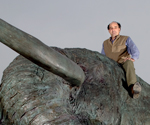Interview: Mark Coreth
Roger Field meets sculptor Mark Coret6.5


What weighs 6.5 tons, is 13ft high, 22ft long and was moving down the M3 motorway at a steady 50mph the other week? Mark Coreth s life-sized bronze elephant is the answer. Mark returned from a trip to northern Kenya determined 'to pay homage to the great elephants of the past and to salute the future of wildlife and conservation'. He wanted to find elephants with each tusk weighing 100lb and more: animals that had once been the prized quarry of the big-game hunters of old. He had been delighted to discover more than half a dozen, a testament to the fact that the gene pool survives and that conservation, at least for the African elephant, is working. His elephant was on its way to a private collection outside Sydney, Australia, by way of Southampton Docks. He has already started casting the second, for a retail park in Italy. There is now just one left, looking for a park to roam in.
The elephantis a very long way from Mark's beginnings in sculpting. I was there in 1979, in The Blues and Royals Officers' Mess, when he showed us a version he had made of a statue of The Royal Dragoons capturing the Eagle of the 105th at Waterloo. We were so impressed that he went into business. First, it was bronze resin animals to bolt onto the bonnets of our cars, followed by animals cast in bronze. Bis-marck was first his favourite bloodhound from the Weser Vale hounds, he recalls fondly. By 1986, he had modelled Belisarius, the regimental drum horse given by the Regiment to the Duke and Duchess of York on the occasion of their marriage. That, he says, was his first serious commission. But it was Africa, and the wonder, majesty and plight of animals in the wild, that was the engine that was beginning to drive him. He had grown up in Kenya. His father, Count Maurice Coreth, had started Rhino Rescue, and it was to raise money for the charity that Mark had his first exhibition at the Sladmore Gallery in 1986: the beginning of a happy and continuing relationship. I and the others marvelled at his extraordinary ability to capture the movement and power of his subjects.
I'm still marvelling all these years later. He has an exhibition every two years, and 2006 saw Five Journeys, including tigers in India, bears in America, a snow leopard modelled at 14,000ft in Ladakh and, perhaps his triumph of 2007, albatross in the Falklands. Captain Coreth had fought in the Falklands in 1982, and he was commissioned to sculpt the memorial for the Falkland Islands Memorial Chapel at Pangbourne. Three life-sized albatross, flying in formation, were officially unveiled by The Queen on June 14, 2007. The Duke of Edinburgh was particularly taken by them, and recalled that when he and The Queen had visited the Falkland Islands in 1959, an albatross had landed on the Royal Yacht. Margaret Thatcher was also fascinated. Tony Blair asked whether they were bronze. Mark said they were.
The then not quite ex-Prime Minister gave a bird a friendly tap and said that he had no idea how bronzes were made. 'Given that you're going to have no shortage of spare time in the near future,' Mark replied, 'why not come to my studio and I ll show you how? Mr Blair looked duly surprised and moved smartly off. Mark is going to need to continue to show no fear. Determined to sculpt wild animals in wild places, and by so doing alert the world to their plight, he is now off to the Arctic: 'I want to sculpt the polar bear while it's still master of its own kingdom.' In fact, with global warming and retreating ice caps threatening the wildlife of the area, he suspects he'll be spending a lot of his time in northern regions in his quest to tell the world just what it's losing, before it's too late.
Read more countryside interviews and stories at www.countrylife.co.uk/countryside
Exquisite houses, the beauty of Nature, and how to get the most from your life, straight to your inbox.
Country Life is unlike any other magazine: the only glossy weekly on the newsstand and the only magazine that has been guest-edited by His Majesty The King not once, but twice. It is a celebration of modern rural life and all its diverse joys and pleasures — that was first published in Queen Victoria's Diamond Jubilee year. Our eclectic mixture of witty and informative content — from the most up-to-date property news and commentary and a coveted glimpse inside some of the UK's best houses and gardens, to gardening, the arts and interior design, written by experts in their field — still cannot be found in print or online, anywhere else.
